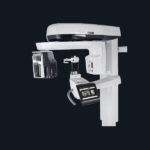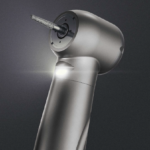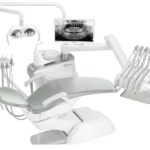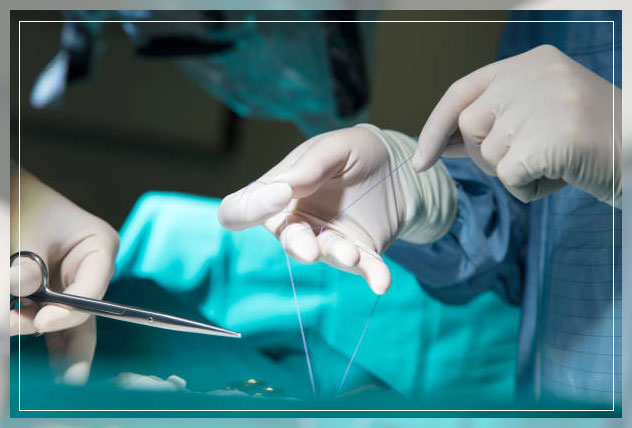
In every hospital and medical center, surgical suture material is an important part.
Surgical suture material helps to close most wound types and the ideal suture allows the patient to heal the tissues.
Moreover, it helps to recover sufficiently to keep the wound closed together once the doctor removes them or they absorb into the skin.
The time it takes for a tissue to no longer need support for surgical material depends on the type of tissue.
For instance, muscles, subcutaneous tissue, or skin takes days, fascia or tendon takes weeks to months, and vascular prosthesis will need months or more to heal.
It is important to note that regardless of suture material composition, the body of the patient reacts to any suture as a foreign body.
Also, it will produce a foreign body reaction to varying degrees.
Keep on reading to learn more about suture materials, size, and components in this guide.
Classification of Suture Materials
Many experts classify sutures into two types:
- absorbable materials
- nonabsorbable materials
Moreover, experts further classify them into synthetic or natural sutures, and monofilament or multifilament sutures.
The ideal suture is the smallest possible that produces uniform tensile strength, securely holds the wound for the required time for healing, then is absrobed.
Also, it should be predictable, easy to handle, produce minimal reactions, and knot securely.
The suture material and type a doctor will choose depends on the clinical scenario.
For instance, as a rough guide, mass closure of a midline laparotomy may need the use of PDS.
A vascular anastomosis will need prolene, a hand-sewn bowel anastomosis will need vicryl, and securing a drain may need a silk suture.
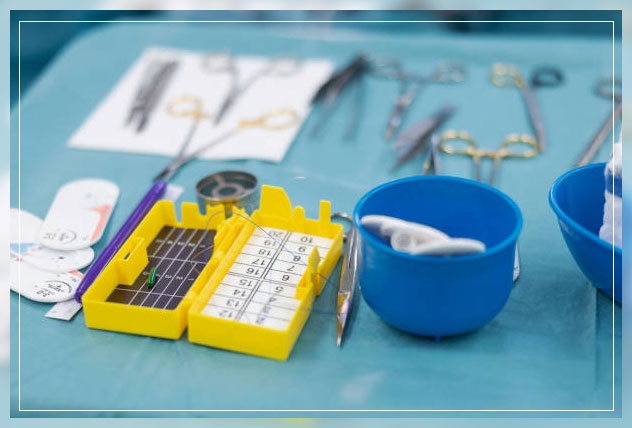
Absrobalbe vs. NonAbsorbable Sutures
The body of the human break down absorbable sutures via enzymatic reactions or hydrolysis.
The time in which this absorption takes place can vary between material, location of the suture, and patient factors.
Moreover, doctors use absorbable sutures for deep tissues and tissues that heal rapidly.
As a result, they may use them in small bowel anastomosis, suturing in the urinary or biliary tracts, or tying off small vessels near the skin.
It is important to note that the absorption time these sutures materials will need depends and vary. For instance:
- Vicryl Rapide = 42 days
- Vicryl = 60 days
- Monocryl = ~100 days
- PDS = ~200 days
Non-Absrobable Sutures
On the other hand, non-absorbable sutures help to provide long-term tissue support.
Also, they tend to remain wall-off by the inflammatory processes of the body until the doctors remove them manually.
Uses of these types of sutures include tissues that heal slowly, like fascia or tendon, closure of abdominal wall, or vascular anastomoses.
Learn more about Types of Wound Dressings here.
Further Classification
Experts further classify sutures are:
Synthetic vs. Natural
Suture materials can be further classified by their raw origin:
Natural sutures are made of natural fibers like silk or catgut.
Doctors do not use them often as they tend to cause a greater tissue reaction.
However, suturing silk is still used regularly in the securing of surgical drains.
On the other hand, synthetic sutures comprise of man-made materials like PDA or nylon.
Moreover, they tend to be more predictable than the natural sutures, particularly in the loss of tensile strength and absorption.
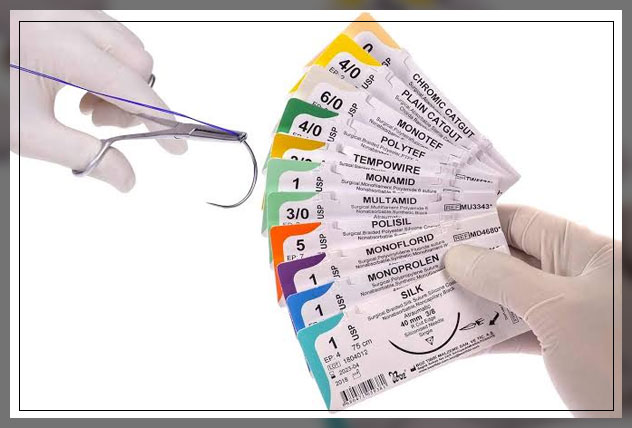
Monofilament vs. Muultifilament
Suture materials are also subclassified by their structure:
Monofilament suture makes use of a single-stranded filament, for instance, nylon, PDS, i.e. polydioxanone suture, or prolene,
They also have a lower risk of infection, however, also have poor knot security and ease of handling.
While multifilament sutures are made of several filaments.
Doctors can twist them together, for instance, braid silk, braided sutures, or vicryl. They handle easier and hold their shape for good knot security, however, can still cause infections.
Consider the following table:
| Suture Type | Absorbable | Non-absorbable | Monofilament | Multifilament |
| Vicryl | ✓ | ✓ | ||
| PDS* | ✓ | ✓ | ||
| Monocryl | ✓ | ✓ | ||
| Nylon | ✓ | ✓ | ||
| Prolene | ✓ | ✓ | ||
| Silk | ✓ | ✓ |
Learn more about Intramuscular Injection: Location and Administration here.
Types of Surgical Needles
Not all manufacturers create equal needles when it comes to sewing up a laceration.
Many provide 2 main types of needles for suturing. cutting needles and tapered needles.
Cutting Needles
This needle is designed with a sharp tip and edges that make them ideal for penetrating the skin.
Therefore, placing skin sutures is easy when doctors make use of them.
Moreover, they can use a cutting needle for most medical procedures.
One specialized type of cutting needle is the reverse-cutting needle.
This one is stronger than the conventional cutting needles and helps to penetrate tough skin.
Tapered Needles.
These types of needles have sharp tips and smooth edges, in comparison to the sharp edges of cutting needles.
Moroever, doctors ideally use these types of needles for subcutaneous tissues that are often difficult to pass through the skin.
Needle Sizes
Once doctors understand the needle sizing terminology, it is simple.
The cod length of the needle also known as bite width is the distance from the swage or where the thread connects to the needle to the needle tip.
The needle length is simply the distance from the stage to the needle tip.
Doctors and other medical health care professionals make sure the needle with the smallest possible length for the procedure to get the best results.
Suture Sizes
Suture sizing is just like the sizing for IVs and injection needles.
The smaller the size of the suture, the larger will be the number.
The smallest suture, for instance, 10-0 will likely never use by a nurse practitioner.
Moreover, these tiny sutures, as fine as human hair, are used for microvascular procedures.

On the other hand, the largest sutures, 00 are as large as fishing lines and doctors or medical healthcare professionals use them for procedures like closing the abdominal wall.
In most cases, doctors use sutures somewhere between 3-0 and 6-0.
Small sutures, like 5-0 and 6-0 are used on the face of the patient.
However, larger sutures like 3-0 and 4-0 are for areas where appearance is not of great concern like in the case of extremities.
Learn more about Ultrasonic Cleaner: How Does it Work? here.
Types of Suture Techniques
The following are the types of surgical suture techniques:
Continuous Suture
A continuous suture is a surgical technique that involves a number of stitches wherein the doctor uses a single strand of the suture thread material.
Moreover, with the help of this technique where doctors apply rapidly while placing sutures.
It is also strong as it allows the tension to be evenly distributed throughout the suture strand.
Interrupted Sutures
These sutures use a technique that uses a number of strands of the suture material in order to close the wound or wound closure.
Once the doctors make the stitch, they will cut off and tie the material.
The interrupted suture technique enables the doctor to close the wound securely so that even if one stitch breaks, the remaining ones can hold the wound together.

Deep Sutures
Another type of surgical suture technique is the deep suture technique.
In this process, the doctor will place the suture under the tissue layers, which are deep below the skin of the patient.
Moreover, the sutures can either be interrupted or continuous.
And doctors can use them in procedures in which the facial layer needs to be closed.
Buried Sutures
Doctors use this technique where the suture knot is present inside, i.e within or under the area they need to close off.
This type of surgical suture is not removed and is often useful when larger sutures are used in the deeper corners of the body as gut sutures.
Other Types
Some other types are:
Purse String Sutures
This one is a type of continuous suture, that doctor will place around the infected area.
The doctor will typically tighten it in a pattern that resembles a drawstring attached to a bag.
Moreover, with the help of this suturing technique, they can help reduce the surface area of a circular wound with the aim of getting minimal scarring.
A Subcuticualr Suture
The doctor or other healthcare professional will place this type in the dermis, i.e. layer of the tissue that lies below the upper layer of the skin of the patient.
It is also known as the subcutaneous suture.
In this type, the doctor will place short stitches in a line, parallel to the wound and will also anchor the stitches on either end of the wound.
Complications from Suture Mateiral
In some cases, suture matieral can cause an allergic reaction at the site of a wound.
Moreover, the infection can take place at the site of the wound.
According to the Centers for Disease Control and Prevention, CDC, the most common cause of necrotizing fasciitis is group A Streptococcus bacterial.
Though the bacterial infection is serious, however, it is rare and can have symptoms like fever, severe pain, red, swollen, and worn skin in the affected area.
In case patients do not get treatment, it can cause dizziness, fatigue, nausea, diarrhea, pus, ulcers, black spots, or blisters on the skin.
Moreover, sepsis is another complication in case there is an infection at the suture site.
It can occur when the body has an extreme response to an infection.
Symptoms are:
- increase heart rate
- fever
- chills and shivering
- disorientation
- severe pain
- shortness of breath
- clammy skin
Therefore, it is important to seek medical advice.
Conclusion
Surgery of different kinds needs different components and apparatus. In most cases, doctors have to tend to and close the wounds, especially after invasive surgery.
The wounds can take several days to recover and the doctor will close them in such a way there is not any further bleeding and infection. They do so with the help of surgical equipment and procedures, i.e. surgical sutures.


